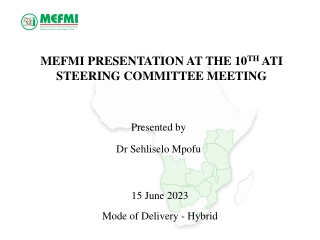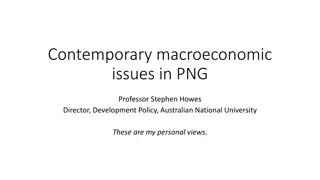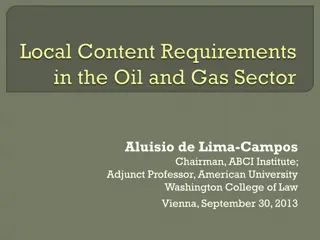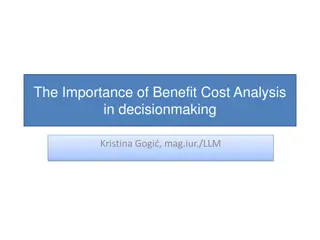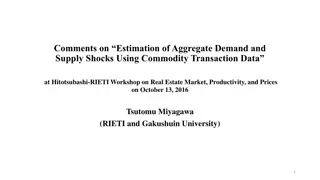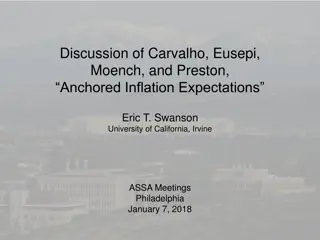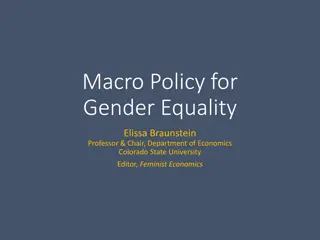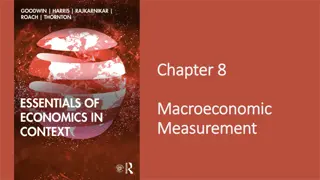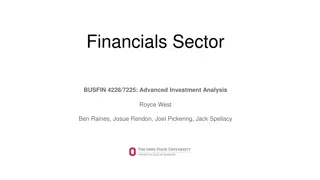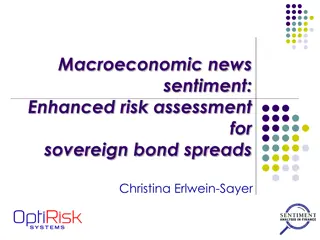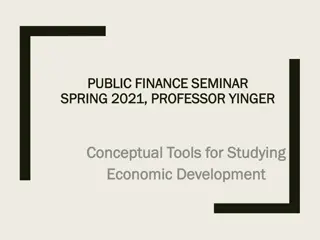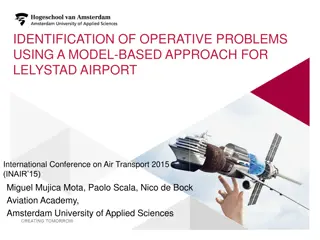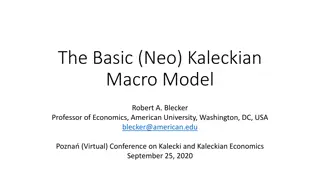Understanding the IS-LM Model for Macroeconomic Analysis
The IS-LM model, discussed in Chapter 12 of Macroeconomics, helps analyze how an economy responds to policy changes and shocks in the short run. By understanding the IS and LM curves and their intersection, we can evaluate short-run macroeconomic outcomes for real interest rates (r) and real output (Y). Shifts in the IS curve, influenced by factors like fiscal policy changes and shocks to the demand for goods and services, play a crucial role in determining economic equilibrium.
Download Presentation

Please find below an Image/Link to download the presentation.
The content on the website is provided AS IS for your information and personal use only. It may not be sold, licensed, or shared on other websites without obtaining consent from the author. Download presentation by click this link. If you encounter any issues during the download, it is possible that the publisher has removed the file from their server.
E N D
Presentation Transcript
Aggregate Demand II: Applying the IS-LM Model Chapter 12 of Macroeconomics, 10thedition, by N. Gregory Mankiw ECO62 Udayan Roy
Applying the IS-LM Model Section 12-1 shows how the IS-LM model that we studied in Chapter 11 can be used to understand how an economy copes with policy changes and disturbances (or, shocks) in the short run Section 12-3 uses section 12-1 to make sense of: The Great Depression of the 1930s, and The Great Recession of 2008-09 Warning: I will skip section 12-2! Very sorry!
Recap of The IS-LM Theory (Ch. 11) Goods market equilibrium conditions ? = ?0+ ?? (? ?) ? = ? + ? + ? ? = ?0 ?? ? Assets market equilibrium conditions ? = ? + ?? ? =?0 ? ? ? r LM 1. The goods market equilibrium equations gives us the IS curve. It is an inverse relation between the real interest rate (r) and real output (Y). IS 2. The assets market equilibrium equations gives us the LM curve. It is a direct relation between r and Y. Y 4. From Ywe ll know C. And from r we ll know both I and i. That would help us make testable predictions about all of our five endogenous variables. 3. The intersection of the IS and LM curves gives us the short-run macroeconomic outcomes for r and Y.
The IS-LM Model: Ch. 11 Summary Goods market equilibrium conditions ? = ?0+ ?? (? ?) ? = ? + ? + ? ? = ?0 ?? ? Assets market equilibrium conditions ? = ? + ?? ? =?0 ? ? ? IS Equation ?? ? ?? ? = ??+ ??+ ? ? ? ? ?? ? ?? ? ?? ? =? ? + ?? ?? LM Equation ?
The IS-LM Model: Ch. 11 Summary Short-run equilibrium in the goods market is represented by a downward- slopingIS curve linking Y and r. Short-run equilibrium in the money market is represented by an upward- slopingLM curve linking Y and r. The intersection of the IS and LM curves determine the short-run equilibrium values of Y and r. The IS curve shifts right if there is: an increase in Co + Io + G, or a decrease in T. The LM curve shifts right if: M/P or E increases, or Lo decreases r LM IS Y
Well now look at shifts of the IS curve FISCAL POLICY AND SHOCKS TO THE DEMAND FOR GOODS AND SERVICES
Shifts of the IS curve Recall that the IS curve shifts right if there is: an increase in Co + Io + G, or a decrease in T, or an equal (balanced budget) increase in both. Simply put, any exogenous change that increases the demand for goods and services shifts the IS curve to the right. r LM r1 IS Y Y1
Shifts of the IS curve Recall that the IS curve shifts right if there is: an increase in Co + Io + G, or a decrease in T, or an equal (balanced budget) increase in both. As a result, both Y and rincrease Simply put, any exogenous change that increases the demand for goods and services increases real output and real interest rates. IS-LM Predictions Y r Co + Io + G T + + r LM r1 IS Y Y1
Shifts of the IS curve Similarly, the IS curve shifts left if there is: an decrease in Co + Io + G, or a increase in T , or an equal (balanced budget) decrease in both. Simply put, any exogenous change that decreases the demand for goods and services decreases real output and real interest rates. IS-LM Predictions Y r Co + Io + G T + + r LM r1 IS Y Y1
Comparing the Keynesian Cross and in the IS Curve In the Keynesian Cross model, expansionary fiscal policy boosts GDP by an amount dictated by the multipliers. Keynesian Cross ?? ? ? = ??+ ??+ ? ? ? ?? ? ?? K.C. Tax-Cut Multiplier K.C. Spending Multiplier In the IS-LM model, expansionary fiscal policy also raises the real interest rate, thereby weakening the effect of fiscal policy on GDP. (Crowding-out effect) ?? ? ?? ? = ??+ ??+ ? ? ? ? ?? ? ?? ? ?? IS Curve
Effect of Demand is Weakened by the Crowding-Out Effect We have just seen that, in the IS-LM model, higher demand for goods and services (Co + Io + G or T ) leads to higher real output but also to higherrealinterest rate. The higher interest rate leads to lower investment spending Because, in IS-LM theory, I = Io Irr. The lower investment spending has a negative effect on real output (Y). This negative effect of higher demand is called the crowding- out effect
Effect of Demand is Weakened by the Crowding-Out Effect This crowding-out effect was absent in the Keynesian Cross model Because, as we saw in Ch. 11, the KC theory assumes that the real interest rate has no effect on investment spending whereas the IS-LM theory assumes I = Io Irr. Thus, although an increase in the demand for goods and services leads to an increase in output in both theories, the increase is smaller in the IS-LM theory than in the Keynesian Cross theory
Government Purchases Stimulus Weakened by Crowding-Out 1 1 ??? ? causing GDP to 1. IS curve shifts right by rise. r 2. This raises money demand, causing the interest rate to rise LM r2 3. which reduces investment, so the final increase in Y is smaller than 1 ??? ?. 2. 1 r1 1. IS2 IS1 Y Y1 Y2 3.
Tax Cut Stimulus Compared to Government Purchases Stimulus Consumers save (1 MPC) of the tax cut, so the initial boost in spending is smaller for T than for an equal G r LM and the IS curve shifts by MPC 1 MPC r2 T 1. 2. r1 1. IS2 so the effects on r and Yare smaller for T than for an equal G. 2. IS1 Y Y1 Y2 2.
Well now look at shifts of the LM curve MONETARY POLICY AND SHOCKS TO THE DEMAND FOR MONEY
Shifts of the LM curve: Effects on Y and r ? =? ? + ?? ?? Recall that the LM curve shifts right if there is: an increase in M or E , or a decrease in Lo or P. In other words, any exogenous change that increases the supply of money or decreases the demand for money shifts the LM curve to the right. ? r LM r1 IS Y Y1
Shifts of the LM curve: Effects on Y and r Recall that the LM curve shifts right if there is: an increase in M or E , or a decrease in Lo or P. As a result, Yincreases and rdecreases In other words, any exogenous change that increases the supply of money or decreases the demand for money increases real output and decreases the real interest rate. r LM r1 IS Y Y1
Shifts of the LM curve: Effects on Y and r Similarly, the LM curve shifts left if there is: a decrease in M or E , or an increase in Lo or P. As a result, Ydecreases and rincreases In other words, any exogenous change that decreases the supply of money or increases the demand for money decreases real output and increases the real interest rate. r LM r1 IS Y Y1
IS-LM Predictions for Y and r IS-LM Predictions IS-LM Predictions Y r IS curve LM curve Y r Co + Io + G T + + Co + Io + G T + + M/P + E + L0 +
Shifts of the LM curve: Effects on i We have just seen how shifts of the IS and LM curve affect real GDP (Y) and the real interest rate (r). But how is the nominal interest rate (i) affected? Recall that ? = ? + ?? Therefore, if expected inflation (??) is unchanged, the effect on i would be identical to the effect on r. Therefore, for any exogenous variable other than E , its effect on i would be identical to its effect on r.
IS-LM Predictions for Y, r and i IS-LM Predictions IS-LM Predictions IS curve LM curve Y r IS curve LM curve Y r i Co + Io + G T + + Co + Io + G T + + + M/P + M/P + Later E + E + L0 + L0 + + For all exogenous variables other than E the effect on i would be identical to the effect on r
Shifts of the LM curve Recall from Ch. 11 that, if expected inflation (E ) decreases, the LM curve shifts up by the exact same amount! Therefore, if E decreases, r increases, but by a smaller amount. Therefore, i = r + E decreases. LM2 r LM1 r2 r r1 E IS Y Y2 Y1
Shifts of the LM curve Here s another way to get the result in the previous slide: Recall that the LM equation is ? =? This is the same as ? =? This gives us ? =? ?0 ? ? We have seen before that when E decreases, Y decreases and all other exogenous variables are unaffected. So, when E decreases, i decreases. IS-LM Predictions IS curve LM curve Y r i ?+?? ?0 Co + Io + G T + + + ? . ? ? ?0. M/P + Later E + . L0 + +
IS-LM Predictions for Y, r and i IS-LM Predictions IS-LM Predictions IS curve LM curve Y r i IS curve LM curve Y r i Co + Io + G T + + + Co + Io + G T + + + M/P + M/P + Later E + + E + L0 + + L0 + + At this point, you should be able to do problems 1, 2, 3 (a) (f), 4, and 5 on pages 362 364 of the textbook. Please try them.
Monetary Policy The practice of changing the quantity of money (M) in order to affect the macroeconomic outcome is called monetary policy an increase in the quantity of money (M ) is called expansionary monetary policy, and A decrease in the quantity of money (M ) is called contractionary monetary policy We saw this in Ch. 4
Shifts of the LM curve r When the central bank increases the quantity of money (M), the LM curve shifts right, real output increases, and both interest rates (r and i) decrease As i = r + E and E is exogenous, r and i decrease by the same amount when M increases LM r1 IS Y Y1
Shifts of the LM curve LM (M2) r A central bank can reliably measure both the quantity of money (M) and the real interest rate (r) So, in conducting its monetary policy, it can guide itself by targeting either the quantity of money or the interest rate LM (M1) LM (M0) r2 r1 r0 IS Y Y2 Y0 Y1 Assume M0 > M1 > M2.
Monetary Policy Re-defined LM (M2) r Therefore, one can re-define expansionary and contractionary monetary policy as follows: Monetary policy is expansionary when the central bank attempts to reduce interest rates (real and nominal), and Monetary policy is contractionary when the central bank attempts to increase the interest rates (real and nominal) LM (M1) contractionary LM (M0) r2 neutral expansionary r1 r0 IS Y Y2 Y0 Y1 Assume M0 > M1 > M2.
The Federal Funds Rate In the United States, the central bank (the Federal Reserve) formally describes its monetary policy by periodically announcing its desired or target level for a nominal interest rate called the Federal Funds Rate Having announced its target level for the FFR, the Fed then adjusts the money supply to steer the actual FFR as close to its target level as possible
The Federal Funds Rate The Federal Funds Rate is the interest rate that banks charge each other for overnight loans If the Fed wishes the FFR to be 1.8%, all it has to do is to announce that it will lend money to any bank at 1.8% interest and will pay 1.8% interest on deposits received from any bank
The Federal Funds Rate Given that the Fed expresses its monetary policy in terms of the target value of the Federal Funds Rate, we can re-define monetary policy as follows: Monetary policy is expansionary when the Fed seeks to reduce the federal funds rate, and Monetary policy is contractionary when the Fed seeks to increase the federal funds rate Assuming expected inflation (E ) is exogenous, changes in nominal interest rates (such as the FFR) lead to equal changes in real interest rates
The Zero Lower Bound on Nominal Interest Rates r We have seen that, when faced with a recession, the central bank can increase the money supply (M ) This shifts the LM curve right This reduces the real interest rate (r = i E ) and the nominal interest rate (i = r + E ) and increases GDP (Y ) This drags the economy out of the recession LM r1 IS Y Y1
The Zero Lower Bound on Nominal Interest Rates r The problem is that there is a limit to how low the nominal interest rate can be Nominal interest rates (such as the federal funds rate) cannot be negative To deal with the 2008 economic crisis, the Fed reduced the FFR to zero But the recession persisted Unfortunately, the Fed could not reduce interest rates below zero: monetary policy had reached its limit LM r1 IS Y Y1
The Zero Lower Bound on Nominal Interest Rates: Financial Crisis of 2008-09 and Covid-19 Pandemic
The Zero Lower Bound on Nominal Interest Rates If the nominal interest rate has been reduced all the way down to zero, and the economy is still stuck in a recession, the economy is said to be at the zero lower bound, or in a liquidity trap See page 356 of the textbook
The Zero Lower Bound on Nominal Interest Rates Suppose the nominal interest rate is zero and the economy is in a recession Expansionary monetary policy can increase output but only if the nominal interest rate can also be reduced at the same time But this is not possible at the ZLB IS-LM Predictions IS curve LM curve Y r i Co + Io + G T + + + M/P + E + + L0 + +
The Zero Lower Bound on Nominal Interest Rates: Solutions When an economy is in a liquidity trap or ZLB, monetary policy cannot be used to reduce interest rates any further But other things could be done to help the economy: Expansionary fiscal policy can be used The monetary authorities (the central bank) can: Make a credible promise to be irresponsible! Make the domestic currency cheaper Conduct quantitative easing
When the Nominal Interest Rates is Zero: The Central Bank can Promise to be Irresponsible! If the central bank makes a believable promise that it will use its monetary policy tools to generate inflation, then expected inflation (E ) will increase This increases both real output (Y) and the nominal interest rate (i) So, this policy works even if the nominal interest rate is at the zero lower bound IS-LM Predictions IS curve LM curve Y r i Co + Io + G T + + + M/P + E + + L0 + +
When the Nominal Interest Rates is Zero: Make the currency s exchange rate cheaper Although this chapter assumes a closed economy, in reality foreign trade does matter. So, the central bank can print domestic currency, and use it to buy foreign currency, thereby making the domestic currency cheaper relative to the foreign currency, thereby stimulating exports, thereby ending the recession!
When the Nominal Interest Rates is Zero: The Central Bank can reduce long-term interest rates! Even when short-term interest rates such as the federal funds rate are at zero percent, the central bank can print money and make long-term loans to the government, to businesses, to home-buyers who need mortgages, etc. This would reduce long-term interest rates directly, thereby stimulating spending by the borrowers This strategy called quantitative easing may also end a recession
THE INTERACTION BETWEEN MONETARY AND FISCAL POLICY
Interaction between monetary and fiscal policy IS-LM Model: Monetary policy (M) and fiscal policy (Gand T) are exogenous. Real world: Monetary policy makers may adjust Min response to changes in Gand T by fiscal policy makers, and vice versa. Such responses by the central bank may affect the effectiveness of fiscal policy
The Feds response to G > 0 Suppose the government increases G and/or decreases T. Possible Fed responses: 1.hold M constant 2.hold r constant 3.hold Y constant In each case, the effects of G and/or T on Y are different
Response 1: Hold M constant r When G increases and/or T decreases, the IScurve shifts right. If the Fed holds M constant, then LM curve does not shift. As a result, interest rates rise. This has a crowding-out effect. Consequently, GDP increases, but not a lot. LM r2 r1 IS2 IS1 Y Y1 Y2
Response 2: Hold r constant r If the government increases G and/or decreases T, the IScurve shifts right. To keep rconstant, the Fed increases M to shift LMcurve right. Results: Y increases from Y1 to Y3, and r is unaffected. There is no crowding-out effect The increase in Y is big as big as in the Keynesian Cross theory LM1 LM2 r2 r1 IS2 IS1 Y3 Y1 Y2 Y
Response 3: Hold Y constant LM2 r If the government increases G and/or decreases T, the IScurve shifts right. To keep Yconstant, the Fed reduces M to shift LMcurve left. Results: Y is unchanged, and r increases from r1 to r3. LM1 r3 r2 r1 IS2 IS1 Y Y1 Y2 At this point, you should be able to do problem 7 on page 353 of the textbook. Please try it.
Estimates of fiscal policy multipliers from the DRI macroeconometric model These statistical estimates confirm that the effect of government spending exceeds the effect of an equal-sized tax cut. Estimated value of Y/ G Estimated value of Y/ T Assumption about monetary policy They also confirm that the effect of fiscal policy is bigger when the central bank holds the interest rate constant, thereby canceling the crowding out effect. Fed holds money supply constant 0.26 0.60 Fed holds nominal interest rate constant 1.19 1.93 A macroeconometric model is a more elaborate version of our IS-LM model, with the parameters given the numerical values that they are estimated to have, based on historical data.
When households and businesses suddenly change their behavior, what are the macroeconomic consequences? SHOCKS IN THE IS-LM THEORY
Shocks in the IS-LMmodel ISshocks: exogenous changes in the demand for goods and services. IS-LM Predictions IS curve LM curve Y r i Examples: stock market boom or crash change in households wealth C0 change in business or consumer confidence or expectations I0 and/or C0 Co + Io + G T + + + M/P + E + + L0 + +
Shocks in the IS-LMmodel LMshocks: exogenous changes in the demand for money. Examples: a wave of credit card fraud increases demand for money (L0 ). more ATMs or the Internet reduce money demand (L0 ). IS-LM Predictions IS curve LM curve Y r i Co + Io + G T + + + M/P + E + + L0 + +



